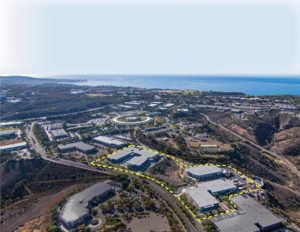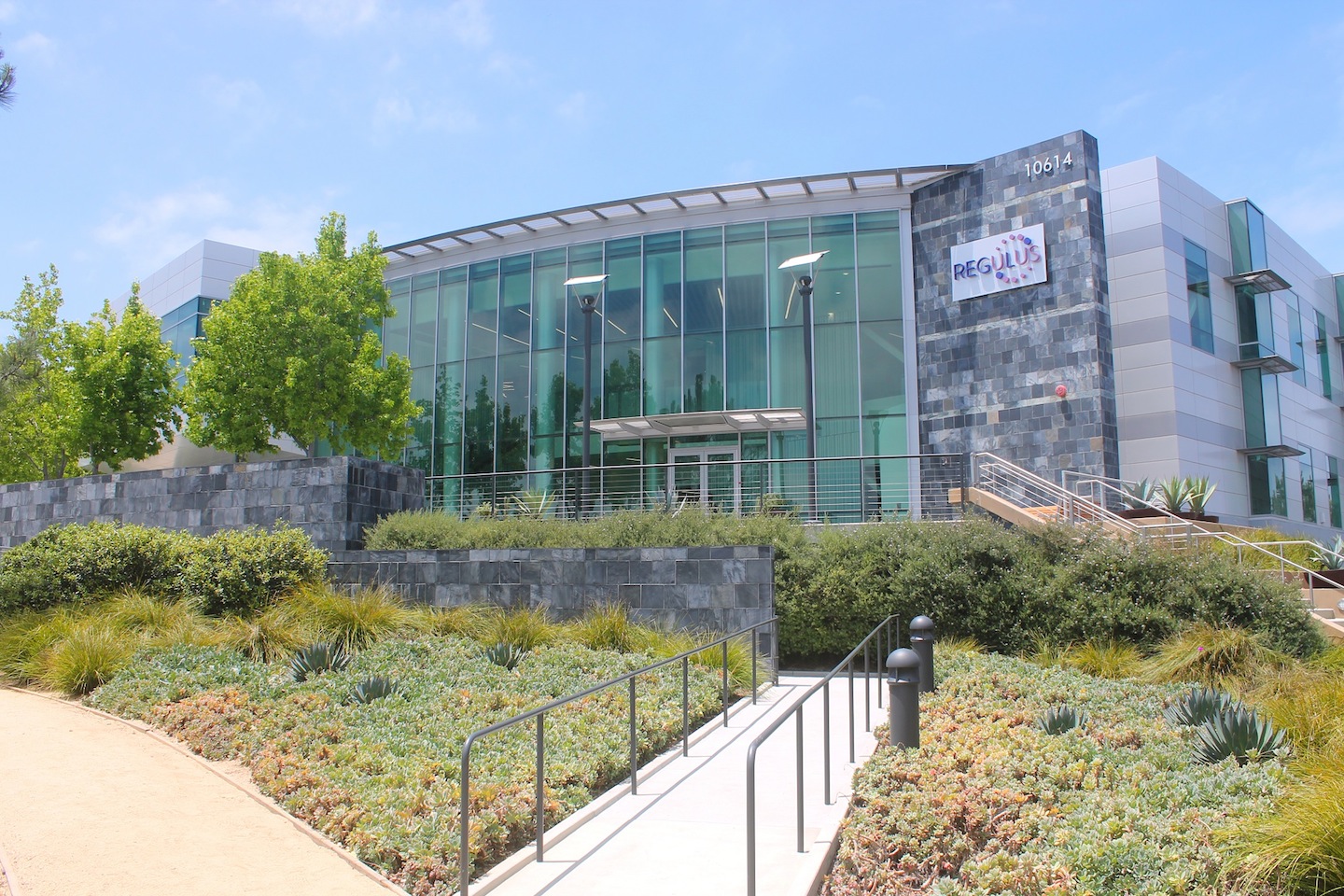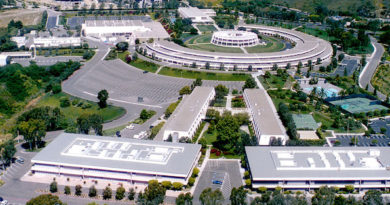Daily Business Report-Oct. 13, 2016
The Torrey Ridge Science Center (Credit: Alexandria Real Estate Equities)
Major San Diego Life Sciences
Cluster Sells for $182.5 Million
Torrey Ridge Science Center, one of San Diego’s largest life sciences campuses, has been sold for $182.5 million to an affiliate of Alexandria Real Estate Equities Inc.

The three-building, 291,799-square-foot property, located at 10578, 10614 and 10628 Science Center Drive, was 87 percent leased at the time of the sale to such tenants as Regulus Therapeutics, Pacira Pharmaceuticals, Nitto BioPharma, Interpreta and BP Technology Ventures. Many of Torrey Ridge Science Center’s existing leases are below market.
Walton Street Capital and StelWave were the sellers.
Torrey Ridge Science Center was built in 2004. Since 2012 the sellers invested $55 million in base building and tenant improvements, including upgrading common areas, signage and landscaping to first-class standards as well as creating a new dedicated central plant and adding chilled water systems for each building. The campus also includes newly built tenant amenities including a fitness center, conference center and Wich Addiction café.
CBRE representing the sellers. Alexandria Real Estate Equities represented itself.
“This was a highly strategic acquisition for Alexandria in Torrey Pines, one of our core San Diego submarkets,” said Daniel J. Ryan, executive vice president and regional market director of San Diego for Alexandria Real Estate Equities. “The Torrey Ridge Science Center campus provides us with the opportunity to achieve significant cash flow growth as leases are renewed or rolled over, given that many of the in-place leases are below market. The campus also gives us the flexibility to convert traditional office space, which is approximately 22 percent of the project, to wet lab research space in order to respond to strong demand from leading biotech entities in San Diego.”
San Diego is home to one of the top three life science clusters in the United States. According to CBRE, the San Diego life science direct vacancy rate in second quarter 2016 was 6 percent and in Torrey Pines the rate was 1.4 percent.
In San Diego, Alexandria is the owner and operator of nearly 4 million rentable square feet of office/laboratory space (including development and redevelopment projects currently under construction) in the Torrey Pines, University Town Center, Sorrento Valley and Sorrento Mesa submarkets.
_________________________

Port Commissioners Could Pick New
Plan for Seaport Village Makeover
Times of San Diego
Port of San Diego Commissioners meeting today could choose a different developer and plan for a major overhaul of Seaport Village.
Six developers submitted bids for the project, and in July, the commissioners chose one called Seaport San Diego for further evaluation.
The four-company entity that proposed Seaport San Diego, 1HWY1, hasn’t actually formed yet. Port staff noted that only one of the partners has experience in mixed-use development, though others have backgrounds in their specialties, like project management and building aquariums.
The other proposals haven’t actually been eliminated, and a different one could be chosen. Port staff plans to present findings so far and ask the board for direction.
The $1.2 billion Seaport San Diego plan calls for three hotels encompassing more than 1,000 rooms, a 151,000-square foot aquarium, a 480-foot- tall observation tower, and a charter school focused on marine studies and music.
There would also be about 165,000 square feet of shopping space, 141,000 square feet of restaurants, 69,000 square feet of space devoted to entertainment venues, specialty cinema and meeting spaces, and 19,000 square feet for offices.
The plan is projected to bring the port $22 million in annual rent once the project is built-out in around 10 years, far above the current take of $2.6 million a year, according to staff.
Staff recommends the board give them six to eight months to, among other things, study hotel market demand, find out which retailers are being targeted for inclusion in the project, determine the fate of current Seaport Village tenants and clarify the marine focus of the proposed charter school.
— City News Service contributed to this article.
_________________________
CONNECT Announces First Successful
Funding Through CapitalMatch
Connect announced the first successful round of funding from its CapitalMatch program with LeadCrunch acquiring $200,000 in matching funds.
LeadCrunch was the first company accepted into CapitalMatch, receiving $200,000 of funding from Bialla Venture Partners 2 LLC. ExCapsa Group is the lead investor. Both firms are based in San Francisco. Other investors include the former CEOs of Net Ratings, Goldman Sachs and FICO.
The CONNECT CapitalMatch program is designed to introduce early stage life science and technology companies to potential sources of funding. After a round of intake panels and qualified investor screenings, companies are deemed ready for investment and introduced to interested investors.
_________________________
San Diego History Center to Accept
Donations Instead of Set Admission Fee
Visitors to the San Diego History Center in Balboa Park and its museum in Presidio Park will no longer have to pay a set admission fee. Instead, they will be asked to set their own price of admission.

The “Give Forward” policy will give the history center the opportunity to engage with more of the San Diego population, and give other visitors the ability to enjoy the museums, according to officials.
“We, like many museums across the country, are seeing a decrease in visitation and engagement,” said Bill Lawrence, executive director of the History Center. “Admissions, although a small part but important part of our organization’s financial base, remain a barrier to entry for many likely visitors. We want to remove these barriers while at the same time provide an opportunity for our visitors to place their own value and support on their experiences. Our visitors will now have the opportunity to give forward to enhance the experience of another visitor.”
Added Lawrence: “Our region’s history is shared by us all, and moving to an admissions model based on generosity offers opportunities to engage our visitors, members, and donors in new and exciting ways. We believe that this new policy will help increase our engagement with the community and in turn provide additional support that will allow the History Center to greater fulfill our mission of preserving and promoting our region’s history.”
The change in admissions policy was inspired by UC San Diego’s Rady School of Management faculty Uri and Ayelet Gneezy who authored the study, “Shared Social Responsibility: A Field Experiment in Pay-What-You-Want Pricing and Charitable Giving” (Science 16 Jul 2010:Vol. 329, Issue 5989, pp. 325-327). Both authors will be working with The San Diego History Center as it makes this move.
_________________________
Application Deadline Nears for SDSU
Online Master’s Degree Program
Nov. 1 is the application deadline for the next grouping in San Diego State University’s Master of Public Administration (MPA) Online degree program that begins in January 2017.
Ranked the No. 1 program of its kind in the California State University system and fifth in California by US News and World Report (2012), this 16-month program is offered to experienced professionals who currently work in government and nonprofit agencies.
The rigorous format has been designed for working professionals who are employed in managerial positions in public administration, nonprofit administration, urban planning, criminal justice, or related fields. Past experience in these fields will be considered for applicants who are not currently working in the public or nonprofit sector.
The 36-unit online curriculum is the same as the campus-based program. However, the fast-track, online program is taught in six, two-month modules with two-on-campus experiences — at the beginning and end of the program.
_________________________
Gift to UC San Diego Will Establish
Region’s First Mother’s Milk Bank

San Diegans Hannah and Zachary Johnson have awarded funds to the University of California San Diego to establish the first community milk bank in the region
The Mother’s Milk Bank, which will be established by the Division of Neonatology at UC San Diego Health, will collect and provide donor milk to local hospitals for the optimal care of infants who need the milk most. The bank will also aim to work with community partners to improve area breastfeeding education and awareness regarding the need for donations of excess milk, as many mothers with excess milk know very little about milk donation. The Mother’s Milk Bank will be led by Dr. Lisa Stellwagen, professor of clinical pediatrics at UC San Diego School of Medicine, and Dr. Jae Kim, professor of clinical pediatrics at UC San Diego School of Medicine.
According to Kim, “We expect to reduce infant morbidity and mortality in the region by generating more milk for the region and building awareness of the importance of human milk for premature infants.”
_________________________
MTS Opens $38 Million
Bus Facility in El Cajon
The San Diego Metropolitan Transit System (MTS) celebrated the grand opening of the East County Bus Operations & Maintenance Facility on Wednesday, furthering the agency’s role in improving regional air quality.
The facility, which was built to LEED Silver standards, will be home to 120 clean-burning Compressed Natural Gas (CNG) buses.
A new CNG fueling station on site will allow MTS to replace diesel-fueled buses with CNG-fueled buses, which provide a 50 percent reduction in NOx emissions, an 85 percent reduction in particulate matter pollution and an 89 percent decrease in CO emissions.
The 34,500-square-foot maintenance building and 10,275-square-foot administrative building sit on 5.5 acres at 544 Vernon Way in the city of El Cajon. It was built at a cost of $38 million from MTS funds, a Federal Transit Administration competitive grant secured by MTS, Transit Development Act (state) and State Transit Assistance Program funds. The construction contractor was Clark Construction.
_________________________
USS Nimitz Concludes
Six-Day Sea Trial Test
ExecutiveGov
The USS Nimitz aircraft carrier arrived in San Diego after a six-day sea trial test to mark the official completion of a 20-month extended planned incremental availability.
The Navy said the USS Nimitz went through sea trials to assess its ship readiness through an evaluation of crew performance and ship equipment operability using system checks and drills. Evaluations included the activation of the ship’s countermeasure washdown and aqueous film forming foam systems, sea and anchor and precision anchoring exercises and ship self-defense weapon testing as well as man overboard drills.
Ensign Lester Quinlin said the certification of the ship’s catapults will play a role in the launch of aircraft from the carrier.
_________________________
$3 Billion Plan to Recycle Wastewater
Into Drinking Water Gets Backing
By City News Service
An environmental impact report on San Diego’s nearly $3 billion plan to recycle wastewater into drinking water received unanimous backing Wednesday from the City Council’s Environment Committee.
Supporters of the so-called “Pure Water San Diego” program say it will provide residents and businesses with a stable, local supply of potable water that won’t be affected by drought or the uncertainties of future imports. The product will be purified and mixed with water from traditional sources before it’s delivered to customers.
A city staff report said city officials aim to begin delivering 30 million gallons of recycled water a day within five years.
By the time Pure Water is fully implemented in about two decades, it will create 83 million gallons of drinking water per day. That’s 33 million gallons more than the output of the desalination plant that opened last year in Carlsbad.
The project would also require the construction of water reclamation facilities, the creation of pipelines to deliver the water to area reservoirs and a way to divert runoff to those new plants, according to a staff report. Diverting the runoff into recycling plants will have the side benefit of reducing discharges from the aging Point Loma Water Treatment Plant, staff said.
Staffers found 31 potential environmental impacts but said all could be mitigated.
The EIR still needs to be approved by the full City Council at an upcoming meeting.
_________________________
Meet John Lennon’s Sister
And the Mersey Beatles
Julia Baird, sister of John Lennon and author of a book on Lennon’s formative years, will appear alongside official tribute band The Mersey Beatles tonight at the David & Dorothea Garfield Theatre, 4126 Executive Drive, La Jolla.

Baird will be selling and signing copies of her book, “Imagine This: Growing Up with My Brother John Lennon,” at the event, which begins at 7:30 p.m.
The book, published in 2007, addresses much reported misinformation on Lennon, his family and his place as one of the greatest composers and lyricists in modern music history. It also examines Lennon’s separation from his mother at age 5 in his native Liverpool and the emotional toll this action would take amid his musical evolution.
From 2002 to 2012, The Mersey Beatles were the resident band at Liverpool’s The Cavern Club, where the Beatles perfected their act before launching the rock revolution of the 1960s. The band has re-created Beatles hits in 20 countries since 1999.
Tickets are $25 and $35. A meet-and-greet with the band and Baird is $55. Click here



